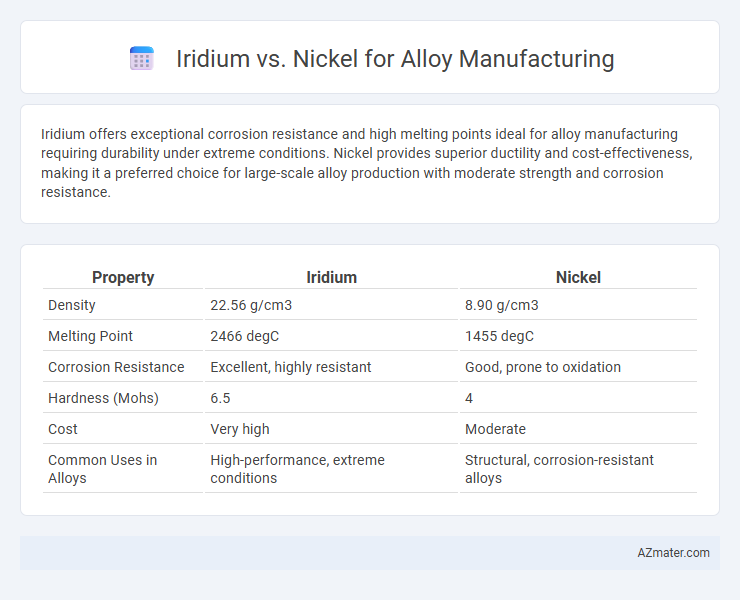Iridium offers exceptional corrosion resistance and high melting points ideal for alloy manufacturing requiring durability under extreme conditions. Nickel provides superior ductility and cost-effectiveness, making it a preferred choice for large-scale alloy production with moderate strength and corrosion resistance.
Table of Comparison
| Property | Iridium | Nickel |
|---|---|---|
| Density | 22.56 g/cm3 | 8.90 g/cm3 |
| Melting Point | 2466 degC | 1455 degC |
| Corrosion Resistance | Excellent, highly resistant | Good, prone to oxidation |
| Hardness (Mohs) | 6.5 | 4 |
| Cost | Very high | Moderate |
| Common Uses in Alloys | High-performance, extreme conditions | Structural, corrosion-resistant alloys |
Overview of Iridium and Nickel in Alloy Manufacturing
Iridium, one of the densest and most corrosion-resistant metals, is primarily used in high-performance alloys requiring exceptional durability and resistance to extreme environments. Nickel, known for its excellent corrosion resistance, high melting point, and ability to form strong alloys, is widely utilized in stainless steel, superalloys, and corrosion-resistant coatings. Combining iridium and nickel in alloy manufacturing enhances properties such as strength, heat resistance, and longevity, making these alloys ideal for aerospace, chemical processing, and electrical applications.
Chemical Properties: Iridium vs Nickel
Iridium exhibits exceptional corrosion resistance and high melting point at 2466degC, making it ideal for high-temperature and chemically aggressive environments, unlike nickel which melts at 1455degC and is more prone to oxidation. Nickel offers excellent ductility and moderate corrosion resistance, often enhancing alloy strength and toughness when combined with other metals. The chemical inertness of iridium under extreme conditions contrasts with nickel's reactivity, influencing their specific applications in aerospace, electronics, and chemical processing industries.
Mechanical Strength and Durability Comparison
Iridium exhibits superior mechanical strength and exceptional durability compared to nickel, making it ideal for high-stress alloy manufacturing applications. Its high melting point and resistance to corrosion contribute to long-lasting performance in extreme environments. Nickel, while offering good toughness and corrosion resistance, generally falls short of iridium's hardness and wear resistance in demanding alloy compositions.
Corrosion Resistance: Iridium vs Nickel
Iridium exhibits exceptional corrosion resistance, outperforming nickel in harsh chemical environments due to its high stability and resistance to oxidation. Nickel, while corrosion-resistant in many applications, tends to oxidize and degrade faster than iridium when exposed to strong acids and extreme temperatures. The superior corrosion resistance of iridium makes it highly suitable for high-performance alloys in aerospace, chemical processing, and medical devices.
High-Temperature Performance in Alloys
Iridium exhibits superior high-temperature stability and corrosion resistance compared to nickel, making it ideal for alloy manufacturing in extreme environments such as aerospace and chemical processing. Alloys containing iridium maintain structural integrity and oxidation resistance at temperatures exceeding 2000degC, outperforming nickel-based alloys that typically degrade above 1000degC. This high-temperature performance advantage drives the use of iridium in critical components requiring durability and reliability under intense thermal stress.
Cost Analysis and Economic Impact
Iridium exhibits a significantly higher cost per kilogram compared to nickel, primarily due to its rarity and complex extraction processes, which substantially influence alloy manufacturing budgets. Nickel, being more abundant and widely mined, offers a cost-effective alternative for large-scale applications, reducing overall production expenses. The economic impact favors nickel alloys for industries prioritizing affordability and scalability, while iridium alloys justify their premium pricing through superior hardness and corrosion resistance in specialized, high-performance sectors.
Alloying Compatibility with Other Metals
Iridium exhibits exceptional alloying compatibility with platinum group metals (PGMs) like platinum and osmium, enhancing corrosion resistance and mechanical strength in high-temperature applications. Nickel's versatility allows it to form stable alloys with a broad range of metals, including copper, iron, and chromium, making it ideal for stainless steel and superalloys used in aerospace and chemical industries. The distinct electronic structures of iridium and nickel influence their alloying behavior, where iridium offers superior hardness and high melting points, while nickel provides excellent ductility and corrosion resistance.
Industrial Applications and Use Cases
Iridium offers exceptional corrosion resistance and high melting point, making it ideal for industrial applications requiring durability in extreme environments such as aerospace and chemical processing equipment. Nickel is widely favored in alloy manufacturing due to its excellent mechanical properties, oxidation resistance, and cost-effectiveness, commonly used in stainless steel production, marine engineering, and turbine blades. Industries often select iridium for specialized, high-performance components while relying on nickel-based alloys for large-scale, economically viable manufacturing solutions.
Environmental and Safety Considerations
Iridium offers superior corrosion resistance and stability in extreme environments, reducing the need for frequent replacements and minimizing environmental waste compared to nickel alloys, which are more prone to oxidation and degradation. The mining and refining of nickel often involve significant environmental hazards such as sulfur dioxide emissions and groundwater contamination, whereas iridium, though rarer, typically requires less processing due to its inert properties. Safety considerations include nickel's potential to cause allergic reactions and respiratory issues in workers, while iridium is generally less reactive, posing fewer occupational health risks in alloy manufacturing.
Future Trends in Alloy Development
Iridium's exceptional corrosion resistance and high melting point position it as a critical element in next-generation high-temperature alloys, especially for aerospace and electronics applications. Nickel-based alloys continue to dominate due to their excellent strength, ductility, and oxidation resistance, with ongoing advancements in additive manufacturing and alloy composition enhancing their performance. Emerging trends indicate increased research into Iridium-nickel composite alloys to leverage synergies for improved durability and efficiency in extreme environments.

Infographic: Iridium vs Nickel for Alloy Manufacturing
 azmater.com
azmater.com